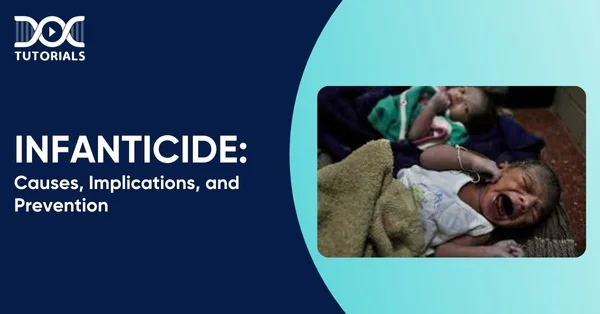Infanticide | Causes, Implications, Prevention

Finding dead bodies of infants in sewers, alleys, trash dumps, and streams is somewhat familiar in large cities. The killing of newborn infants has been practised from an ancient time for a variety of reasons.
One of the basic reasons was the survival of the fittest, or the safety of the tribe, i.e. those with some malformations or having less potential value for the family (such as females) were to be killed.
Superstitions, poverty, and ignorance may be the other factors, especially among the village folk. For NEET PG students and forensic professionals, understanding infanticide’s meaning is essential, not just for legal context but also for recognising its medical, psychological, and societal implications.
Keep reading for a detailed insight.
What is Infanticide?
Infanticide refers to the deliberate act of killing an infant, typically defined as a child under one year of age. The term originates from Latin roots: infans (meaning “infant”) and -cide (meaning “to kill”).
In most countries, it is considered a grave criminal offence, though legal definitions and sentencing may vary. Infanticide does not include the death of a fetus during labour when it is destroyed by craniotomy or decapitation.
What are the Causes of Infanticide?
Infanticide is a complex issue influenced by a combination of psychological, socio-economic, cultural, and medical factors. The causes can be categorised as natural and unnatural (accidental and criminal):
1. Natural Causes
- Immaturity: A prematurely born child generally dies immediately after birth. In the case of the premature birth of a child, the question may arise as to whether the birth was criminally induced or not, for under the Indian Penal Code (IPC), the criminal induction of premature labour is an offence.
- Debility: Due to a lack of general development, even a full-term child may die after birth from debility. In these cases, no disease, except atelectasis of some portions of the lungs due to feeble respiration, is detected.
- Congenital Diseases and Malformations: Syphilis and some fevers may cause death from the toxaemic condition. Among the diseases affecting the internal organs, pulmonary infections and hyaline membranes of the lungs are commonly observed.
Certain conditions, such as anencephaly, spina bifida, and congenital diaphragmatic hernia, are readily identifiable, although subtle cardiovascular or metabolic abnormalities may be difficult to diagnose. Moreover, monstrosity or malformation is no justification for taking the life of an infant.
- Spasms of the Larynx: It may occur from mucus or meconium being aspirated into the larynx or from the enlargement of the thymus gland.
- Erythroblastosis Fetalis: This can develop due to iso-immunisation when an RH-negative woman is carrying an RH-positive fetus, which may result in the death of the fetus.
- Birth Asphyxia: This can occur in preeclampsia or eclampsia, placenta abruption, cephalo-pelvic disproportion, and shoulder dystocia.
Evidence of asphyxia at autopsy includes thymic, pleural, and epicardial petechiae with intra-alveolar haemorrhage, meconium on the skin, and shed fetal skin within distal air passages.
2. Unnatural Causes
- Accidental Causes
I. Perinatal
i. Injuries to the Mother: It may cause premature separation of the placenta or injury to the fetus (concussion of the brain/fracture/rupture of blood vessels) and lead to death of the baby.
ii. Prolonged Labour: It causes the death of the fetus due to injury to the brain because of compression of the head or due to asphyxia.
iii. Prolapsed Cord or Pressure on Cord: It may cause stoppage of fetal circulation during birth, and death of the newborn may develop during or just after birth.
iv. Twisting of Cord around the Neck or Knots of the Cord: It causes death of the fetus during birth or immediately after birth from asphyxia due to strangulation.
v. Death of the Mother: If the death of the mother happens slowly from haemorrhage, there is little chance of saving the child, but it may be saved if an attempt is made to extract it within 25 minutes after sudden death from an accident of the previously healthy mother.
II. Postnatal
i. Suffocation: Due to the non-availability of nursing care, the neonate may die due to smothering or choking due to inhalation of amniotic fluid or blood immediately after birth.
ii. Precipitate Labour: It may cause the death of the newborn due to head injury, suffocation or drowning, or occasionally due to bleeding from the torn end of the attached umbilical cord.
iii. Medico-Legal Aspects: The death of the newborn due to precipitated labour may be taken as a case of deliberate infanticide.
The mother may claim infanticide (negligence on the part of the doctor), but the death of the newborn is due to precipitated labour.
- Criminal Causes
- Acts of Commission
i. Strangulation: Strangulation by a ligature material or the umbilical cord (to simulate the natural twisting of the cord around the neck) or by throttling.
ii. Poisoning: Earlier, opium was used for the purpose (ideal infanticidal poison). Nowadays, acids and insecticides are used.
iii. Smothering: Smothering the baby to death with the help of a hand or clothes.
iv. Head Injury: The head of the fetus may be struck against a wall or the floor by holding its legs; this may leave an impression on the legs as well.
v. Concealed Puncture Wound: This may be caused by a nail or a needle through the fontanelle, nape of the neck or inner canthus of the eye.
vi. Twisting the Neck: Death occurs due to fracture dislocation of the cervical vertebrae and injury to the medulla.
vii. Burning: Burning the newborn alive or disposing of the living newborn inside an oven.
viii. Drowning: This also serves the purpose of disposing of the unwanted child.
ix. Cutthroat Injury: Deaths are primarily due to airway obstruction from smothering or strangulation.
Strangulation marks around the neck with bruising from the hand, or parchment abrasions from ligatures that may have been left in situ; bruising with subgaleal, extradural and subdural haemorrhages, skull fractures and cerebral lacerations, and contusions from blows to the head with blunt objects may be seen.
Drowning and smothering may leave minimal findings.
- Act of Omission or Neglect
i. Not providing proper assistance during labor.
Ii. Obstructed air passages by amniotic fluid/mucus.
iii. Not protecting the child from exposure to extreme heat or cold. Failure to adequately clothe or place an infant in a warm environment may result in fatal hypothermia.
iv. Failure to supply the child with proper food.
What are the Implications of Infanticide?
From the point of view of law, the offence against children may be dealt with on the same lines as if the victim were an adult. In India, there is no distinction in law between infanticide and murder, such as exists in many Western countries like England, Germany, France, etc.
- Infanticide is charged under Section 302 IPC, which is punishable by death or imprisonment for life and a fine.
- The cause of the death of a living child in the mother’s womb may amount to culpable homicide if any part of that child has been brought forth, though the child may not have breathed or been entirely born (Section 299 IPC).
- Any person who does an act with the intent to prevent the child from being born alive or to cause it to die after birth (except done in good faith to save the life of the mother) is punished with imprisonment up to 10 years with/without fine (Section 315 IPC).
- Any person who does an act causing the death of a quick unborn child would be guilty of culpable homicide and punished with imprisonment up to 10 years and a fine (Section 316 IPC).
For example, if a person knowingly injures a pregnant woman, causing the death of an unborn child, he is guilty of the offence defined in this section.
High rates of infanticide signal systemic failures, lack of mental health care, poor maternal support, and societal pressures. Female infanticide leads to skewed sex ratios, long-term social imbalances, and increased violence against women.
What are the Prevention Strategies for Infanticide?
Preventing infanticide requires a multi-pronged approach, including the following:
1. Mental Health Screening & Treatment
- Routine postpartum screening for depression and psychosis
- Access to psychiatric care, especially for at-risk mothers
2. Community and Social Support
- Parenting helplines and crisis centres
- Shelter homes for unwed or abused mothers
- Empowering community health workers to identify red flags early
3. Education and Awareness
- School and community programs on gender equality and reproductive health
- Breaking the stigma around mental illness and single motherhood
4. Legal Reforms and Enforcement
- Strengthening laws that prevent gender-based discrimination
- Encouraging timely reporting of domestic abuse or child neglect
FAQs About Infanticide
1. What is battered baby syndrome?
A battered child has received repetitive physical injuries as a result of non-accidental violence produced by a parent or a guardian.
2. How is infanticide different from murder?
While both involve unlawful killing, courts may consider mental illness or postpartum conditions in infanticide, potentially leading to different sentencing.
3. What are the signs a mother may be at risk of infanticide?
Warning signs include severe mood swings, detachment from the baby, hallucinations, suicidal thoughts, or expressions of fear about harming the child.
4. How can communities help prevent infanticide?
By supporting maternal mental health, reducing stigma, offering crisis support, and educating families about available resources.
5. Are men ever involved in infanticide cases?
Yes. While maternal infanticide is more studied, fathers and other caregivers may also be involved, often due to domestic violence, mental illness, or substance abuse.
Conclusion
Understanding what is infanticide goes beyond legal definitions. Preventing infanticide requires compassion, awareness, legal support, and accessible healthcare. In the medical community, staying informed and proactive ensures not only academic readiness but also a meaningful impact in real-world practice.
For focused exam preparation of clinical cases, platforms like DocTutorials offer high-yield insights across forensic medicine, psychiatry, and community health. Join DocTutorials and explore our NEET PG course today!
Latest Blogs
-

NEET SS Exam 2024: Analysis, Key Dates, Counselling
The NEET SS 2024 exam kicked off on March 29, 2025. Over two days and two slots, candidates across 13…
-

NEET PG Registration 2025: An Essential Guide For Exam Prep
The NEET PG registration, which is conducted online, is a crucial step in the exam process. Filling out the NEET…
-

NEET PG Syllabus 2026: A Must-Have Complete Guide for Exam Success
The NEET PG Syllabus acts as one of the foundation stones for aspiring postgraduate medical students like you who are…




